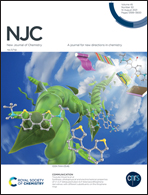Theoretical investigation of the nature of π(B![[triple bond, length as m-dash]](https://www.rsc.org/images/entities/char_e002.gif) B)⋯M interactions in coinage metal π-diborene complexes†
B)⋯M interactions in coinage metal π-diborene complexes†
Abstract
Transition metal π-diborene species exhibit fascinating photophysical properties, and their unique properties reflect their particular electronic structure. In this work, the nature of π(B![[triple bond, length as m-dash]](https://www.rsc.org/images/entities/char_e002.gif) B)⋯M interactions in coinage metal π-diborene complexes, B2IDip2⋯nMCl (n = 1, 2, 3; M = Cu, Au, Ag), was characterized within the framework of energy decomposition analysis, natural bond orbital analysis, atoms in molecule theory, and the electron localization function method. The calculated results show that the M atom of MCl interacts with two boron atoms of B2IDip2 to form an η2-coordinated structure. The π(B
B)⋯M interactions in coinage metal π-diborene complexes, B2IDip2⋯nMCl (n = 1, 2, 3; M = Cu, Au, Ag), was characterized within the framework of energy decomposition analysis, natural bond orbital analysis, atoms in molecule theory, and the electron localization function method. The calculated results show that the M atom of MCl interacts with two boron atoms of B2IDip2 to form an η2-coordinated structure. The π(B![[triple bond, length as m-dash]](https://www.rsc.org/images/entities/char_e002.gif) B)⋯M interactions belong to the Dewar–Chatt–Duncanson model, the charge transfers from IDip to π(B
B)⋯M interactions belong to the Dewar–Chatt–Duncanson model, the charge transfers from IDip to π(B![[triple bond, length as m-dash]](https://www.rsc.org/images/entities/char_e002.gif) B) bonds first and then from π(B
B) bonds first and then from π(B![[triple bond, length as m-dash]](https://www.rsc.org/images/entities/char_e002.gif) B) bonds to the MCl. In π(B
B) bonds to the MCl. In π(B![[triple bond, length as m-dash]](https://www.rsc.org/images/entities/char_e002.gif) B)⋯M interactions, electrostatic interactions are dominant, and orbital interactions are important. The strengths of π(B
B)⋯M interactions, electrostatic interactions are dominant, and orbital interactions are important. The strengths of π(B![[triple bond, length as m-dash]](https://www.rsc.org/images/entities/char_e002.gif) B)⋯M interactions increase in the sequence of M = Ag, Cu, and Au for the same n. The formation of π(B
B)⋯M interactions increase in the sequence of M = Ag, Cu, and Au for the same n. The formation of π(B![[triple bond, length as m-dash]](https://www.rsc.org/images/entities/char_e002.gif) B)⋯M interactions weakens the B
B)⋯M interactions weakens the B![[triple bond, length as m-dash]](https://www.rsc.org/images/entities/char_e002.gif) B and B-C bonds in B2IDip2. In particular, the B
B and B-C bonds in B2IDip2. In particular, the B![[triple bond, length as m-dash]](https://www.rsc.org/images/entities/char_e002.gif) B bonds become increasingly weaker with an increasing number of MCl, followed by M = Ag, Cu, and Au.
B bonds become increasingly weaker with an increasing number of MCl, followed by M = Ag, Cu, and Au.
![Graphical abstract: Theoretical investigation of the nature of π(B [[triple bond, length as m-dash]] B)⋯M interactions in coinage metal π-diborene complexes](/en/Image/Get?imageInfo.ImageType=GA&imageInfo.ImageIdentifier.ManuscriptID=D1NJ02744A&imageInfo.ImageIdentifier.Year=2021)


 Please wait while we load your content...
Please wait while we load your content...
![[triple bond, length as m-dash]](https://www.rsc.org/images/entities/h2_char_e002.gif) B)⋯M interactions in coinage metal π-diborene complexes
B)⋯M interactions in coinage metal π-diborene complexes